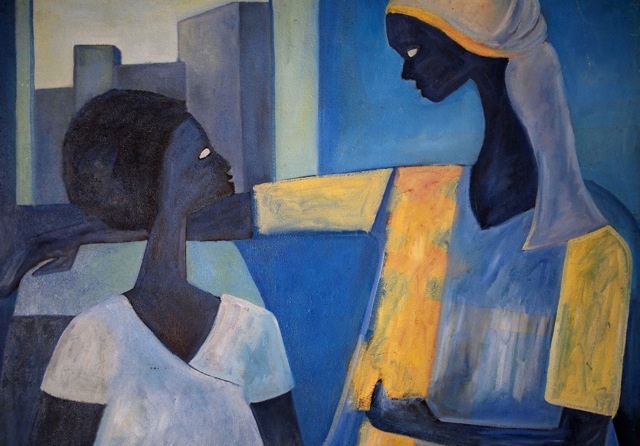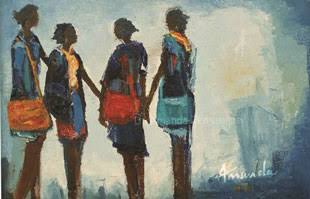
Women artists will largely refer to women who use their artistic practice to interrogate themes of womanhood, sexuality, love and women empowerment
Kampala, Uganda | DOMINIC MUWANGUZI | The phrase Women artists may have become popular on the Ugandan art scene in recent times but within western art circles, it has existed since the early 1970s. It emerged after the seminal essay by feminist art historian Linda Nochlin’s “Why Have There Been No Great Women artist?” The article sought to examine why there were no female artists worthy of their name hitherto yet throughout history women had been involved in making art. The article gave reasons such as the systematic obstruction to art education and absence to patronage encountered by artists of the female gender. On the other hand, men leveraged on these factors which incidentally led to the existence of many great male artists throughout history. Within the Uganda situation, it is quite strange that the term only gained currency during the second half of the new millennium. Traditionally women were known to create baskets, mats and Beadworks which involved elements of art production. Indeed, they were artists but the traditional social structure of African society with its masculinity- which interestingly still exists to today- would never allow women to assert themselves as such.
The prevalent use of the phrase Women artists today on the local art scene and elsewhere on the continent is a rejoinder to the promotion of feminist sentiments which punctuated Nochlin’s essay. As such, it is a norm to have exhibitions by Women artists headlined with themes of femininity like women rights and freedoms, empowerment, identity and womanhood. This approach to art implicitly erodes the stereotype of women as “back benchers” and only fit to perform domestic roles. Noteworthy, the prejudices held against women as inferior and worthless have traditionally been shared across the continents. The breaking of barriers through staging exhibitions which advocate and create awareness about the presence of women as artists is a succinct way to open doors for more young women to join the art profession.

The trend to mount exhibitions exclusively for Women artists has been happening on the Kampala contemporary art scene in recent times. The Njabala Art exhibition is one such example that showcases artworks of Women artists. Produced by the Njabala Foundation with a core objective to promote works of art, publications that facilitate conversations on womanhood, the exhibition has exhibited works of artists like Immy Mali, Pamela Enyonu and Batsheeba Okwenje, Lilian Nabulime and Sandra Suubi. In the last two editions of the annual show, the artists produced and showcased artworks which interrogated the subject of womanhood, love and activism. Similarly through the project Pillars of Rectitude, the foundation seeks to reclaim works of art by Women artists of the 1960s and interrogate them within the contemporary context.
But are there challenges for such a trend which exists in an industry saturated with so many diverse opinions? Yes. The criticism that has always been levelled at the Women artists is the production of art that underlies affirmative action. While it is plausible to have art that asserts the identity of women in contemporary society and creates awareness on the respect of their human rights, not all women who’re involved in the practice of art making support this “radical” approach to art. Maria Naita was comfortable being described as an artist and not woman artist because of the possible limitations and misrepresentations the feminist vocabulary would bestow on her career. But she was a woman, mother and wife who believed that women too had a contribution to make in art through mirroring the life they lived. She nonetheless, deliberately avoided the feminist overtones in her art that would possibly misconstrue the message in her art. Equally, there’re a host of young and established female artists who choose to retrain from making art that interrogates perennial themes of womanhood, sexuality and women empowerment.

This stance validates the argument that “gender alone cannot be a unifying category in the visual arts as it was just arbitrary as defining art by country, race, ethnicity or sexual orientation its maker”-Kelly Deep well, Art Criticism and the State of Feminist Art Criticism. Deepwell here suggests that despite its good intentions the art world trend of women artists possesses weakness in the way it inadvertently propagates divisions among artists of the same gender. This “non unifying category” alluded to by the feminist art critic has the potential to weaken the art if its solely defined by the sentiments or intentions harboured by its producer; which maybe unpopular to a certain audience. This is essentially true if one is to critically observe exhibitions whose primary objective is to promote advocacy and awareness of women set in spaces predominantly occupied by the male gender. Their success is relative compared to when staged in spaces where women activists highly dominate.
The art world trend of Women artists has motivated many young women to join the profession. As such, issues that predominantly affect women like freedom of expression and women empowerment are shed light on and debated on. But with these conversations comes the question if such a trend doesn’t ironically segregate among artists of the same gender. if it does, what is being done to merge this discord?
*****
Images courtesy of Startjournal.org
 The Independent Uganda: You get the Truth we Pay the Price
The Independent Uganda: You get the Truth we Pay the Price


